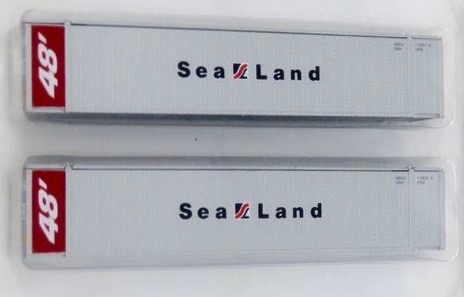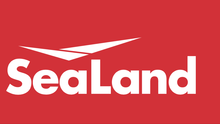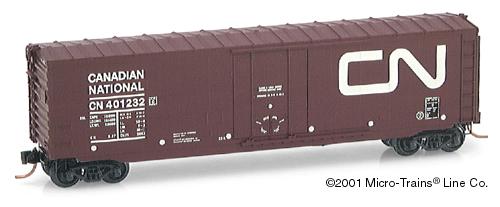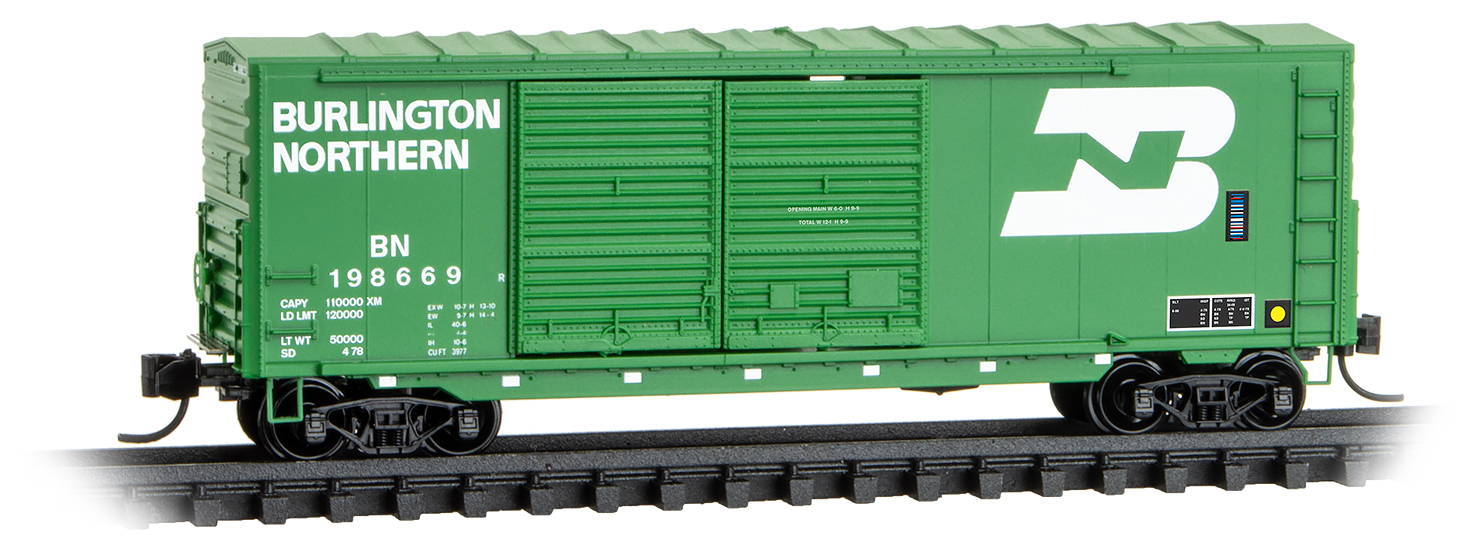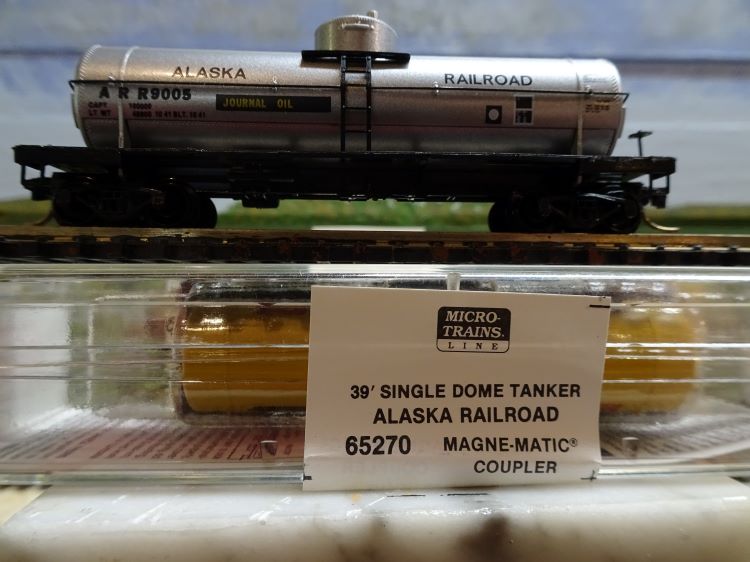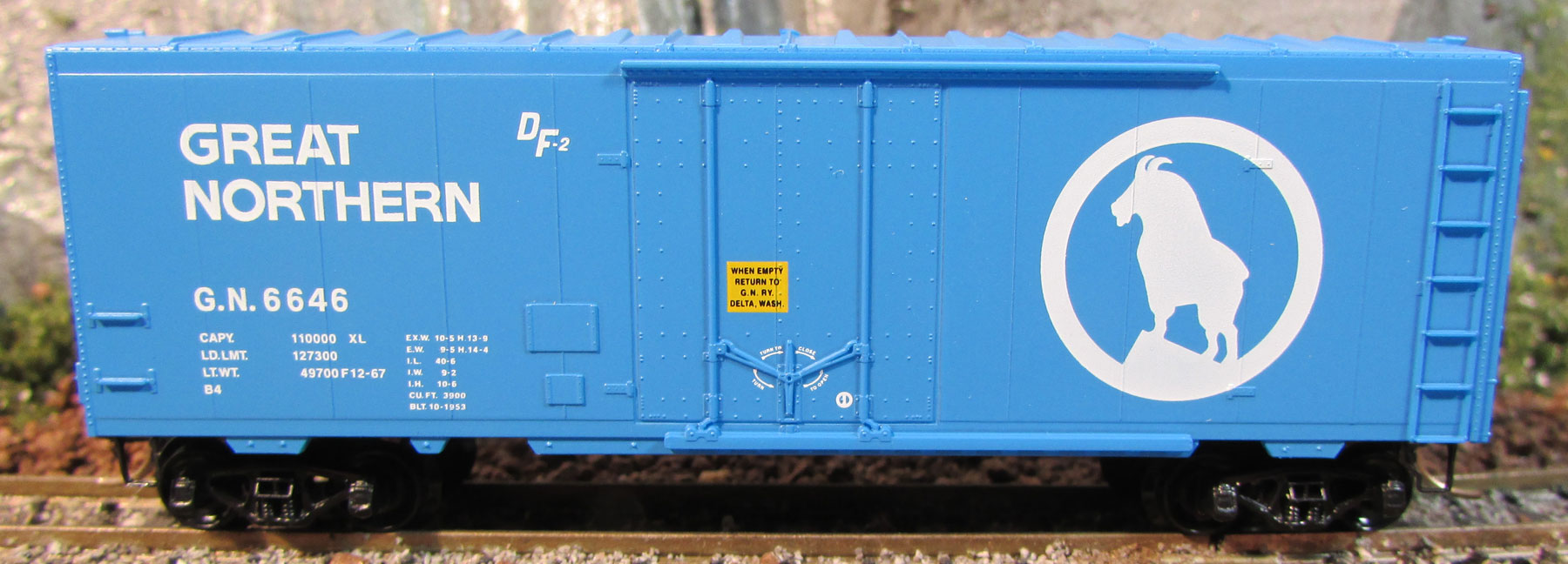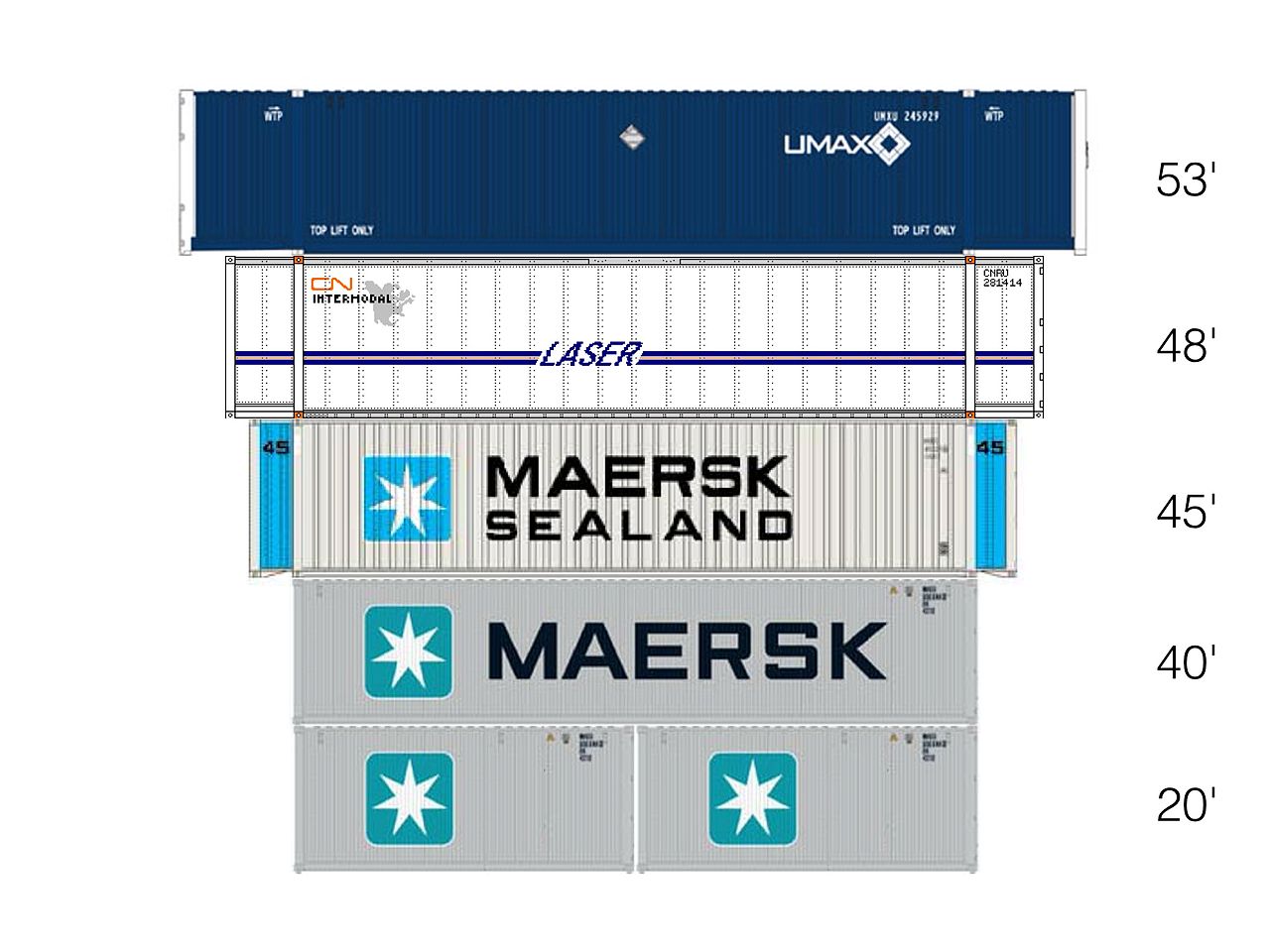Con-Cor - 0004-048010 - Container, 48 Foot - Sea-land - 2-Pack
| Stock Number | 0004-048010 |
| Original Retail Price | $19.98 |
| Brand | Con-Cor |
| Manufacturer | Con-Cor |
| Body Style | Con-Cor Container 48 Foot Smooth Side |
| Prototype Vehicle | Container, 48 Foot (Details) |
| Road or Company Name | Sea-land (Details) |
| Reporting Marks | SEAU |
| Road or Reporting Number | 2-Pack |
| Paint Color(s) | White |
| Print Color(s) | Blue & Red |
| Multipack | Yes |
| Multipack Count | 2 |
| Multipack ID Number | 0004-048010 |
| Item Category | Container |
| Model Type | Intermodal |
| Model Subtype | 48 Foot |
| Model Variety | Smooth Side |
| Prototype Region | North America |
| Prototype Era | NA Era V: Modern Diesel (1979 - Present) |
| Scale | 1/160 |
Prototype History:
An intermodal container is a large standardized shipping container, designed and built for intermodal freight transport, meaning these containers can be used across different modes of transport – from ship to rail to truck – without unloading and reloading their cargo. Intermodal containers are primarily used to store and transport materials and products efficiently and securely in the global containerized intermodal freight transport system, but smaller numbers are in regional use as well. These containers are known under a number of names, such as simply container, cargo or freight container, ISO container, shipping, sea or ocean container, container van or (Conex) box, sea or c can.
The 48-foot (14.63 m) shipping container is a High Cube container in that it is 9 ft 6 in (2.90 m) tall on the exterior. It is 8 ft 6 in (2.59 m) wide which makes it 6 inches (15 cm) wider than ISO-standard containers. This size was introduced by container shipping company APL in 1986, and is used domestically in North America on road and rail, and may be transported on deck by ship. This size being 8 feet (2.44 m) longer and 6 inches (15 cm) wider has 29% more volume capacity than the standard 40-ft High Cube, yet the cost to move it by truck or rail are almost the same.
From Wikipedia
The 48-foot (14.63 m) shipping container is a High Cube container in that it is 9 ft 6 in (2.90 m) tall on the exterior. It is 8 ft 6 in (2.59 m) wide which makes it 6 inches (15 cm) wider than ISO-standard containers. This size was introduced by container shipping company APL in 1986, and is used domestically in North America on road and rail, and may be transported on deck by ship. This size being 8 feet (2.44 m) longer and 6 inches (15 cm) wider has 29% more volume capacity than the standard 40-ft High Cube, yet the cost to move it by truck or rail are almost the same.
From Wikipedia
Road Name History:
Malcom McLean secured a bank loan for $22 million and in January 1956 bought two World War II T-2 tankers. On April 26, 1956, with 100 invited dignitaries on hand, one of the converted tankers, the SS Ideal-X (informally dubbed the "SS Maxton" after McLean's hometown in North Carolina), was loaded and sailed from the Port Newark-Elizabeth Marine Terminal, New Jersey, for the Port of Houston, Texas, carrying fifty-eight 35-foot (11 m) Trailer Vans [8] later called containers, along with a regular load of liquid tank cargo. As the Ideal-X left the Port of Newark, Freddy Fields, a top official of the International Longshoremen's Association, was asked what he thought of the newly fitted container ship. Fields replied, "I'd like to sink that son of a bitch." McLean flew to Houston to be on hand when the ship safely docked.
SeaLand, now a division of the Maersk Group, is an intra-regional container shipping company headquartered in Miramar, Florida with representation in 29 countries across the Americas. The company offers ocean and intermodal services using container ships, trucks, and rail serving customers between North and South America, Central America and the Caribbean
In March 1999, CSX separated SeaLand into three entities: an international shipping company, a domestic shipping company, and a terminal operator.
In December 1999, Maersk Line’s parent company A.P. Moller – Maersk acquired the international container shipping business and the SeaLand name.
In 2000, Maersk Line changed its commercial name globally to "Maersk SeaLand" as a result of SeaLand’s acquisition the previous year.
In 2003, the Carlisle Group bought the domestic shipping line from CSX and changed the name to Horizon Lines.
In 2006, the commercial name SeaLand ceased to exist when, the then known as "Maersk SeaLand," changed its name to "Maersk Line" after the purchase of Royal P&O Nedlloyd.
In January 2014, due to the strong brand recognition throughout the intra-Americas region, the Maersk Group announced the revival of the SeaLand brand as a specialized intra-regional carrier, taking over the existing Maersk Line network for intra-Americas trade starting January 2015.
In January 2015, SeaLand started operations as the standalone carrier of the Americas for Maersk Group.
SeaLand, now a division of the Maersk Group, is an intra-regional container shipping company headquartered in Miramar, Florida with representation in 29 countries across the Americas. The company offers ocean and intermodal services using container ships, trucks, and rail serving customers between North and South America, Central America and the Caribbean
In March 1999, CSX separated SeaLand into three entities: an international shipping company, a domestic shipping company, and a terminal operator.
In December 1999, Maersk Line’s parent company A.P. Moller – Maersk acquired the international container shipping business and the SeaLand name.
In 2000, Maersk Line changed its commercial name globally to "Maersk SeaLand" as a result of SeaLand’s acquisition the previous year.
In 2003, the Carlisle Group bought the domestic shipping line from CSX and changed the name to Horizon Lines.
In 2006, the commercial name SeaLand ceased to exist when, the then known as "Maersk SeaLand," changed its name to "Maersk Line" after the purchase of Royal P&O Nedlloyd.
In January 2014, due to the strong brand recognition throughout the intra-Americas region, the Maersk Group announced the revival of the SeaLand brand as a specialized intra-regional carrier, taking over the existing Maersk Line network for intra-Americas trade starting January 2015.
In January 2015, SeaLand started operations as the standalone carrier of the Americas for Maersk Group.
Brand/Importer Information:
Con-Cor has been in business since 1962. Many things have changed over time as originally they were a complete manufacturing operation in the USA and at one time had upwards of 45 employees. They not only designed the models,but they also built their own molds, did injection molding, painting, printing and packaging on their models.
Currently, most of their manufacturing has been moved overseas and now they import 90% of their products as totally finished goods, or in finished components. They only do some incidental manufacturing today within the USA.
Important Note: The Con-Cor product numbering can be very confusing. Please see here in the article how to properly enter Con-Cor stock numbers in the TroveStar database.
Currently, most of their manufacturing has been moved overseas and now they import 90% of their products as totally finished goods, or in finished components. They only do some incidental manufacturing today within the USA.
Important Note: The Con-Cor product numbering can be very confusing. Please see here in the article how to properly enter Con-Cor stock numbers in the TroveStar database.
Item created by: CNW400
on 2020-10-17 10:18:46
Last edited by: gdm on 2020-12-21 07:30:10
If you see errors or missing data in this entry, please feel free to log in and edit it. Anyone with a Gmail account can log in instantly.
Last edited by: gdm on 2020-12-21 07:30:10
If you see errors or missing data in this entry, please feel free to log in and edit it. Anyone with a Gmail account can log in instantly.


